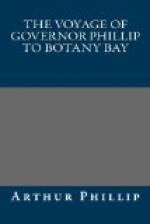At ten in the morning, on Monday July 21, the master of the Friendship went on board the Alexander, and Carteret’s harbour in New Ireland, was appointed by Lieutenant Shortland as the place of rendezvous. The same day, at half past five in the afternoon, land was discovered, bearing from south-west by west, to west half south, at the distance of about eight leagues. It trended to the north-north-west, and was about six or seven leagues in length, the land very high, with a remarkable peak, which bore south-south-west. This island was now named Sir Charles Middleton’s Island: It lies in latitude 28 deg.. 10. south, and in longitude 159 deg.. 50. east. Lieutenant Shortland thinks it probable that the reef seen on the preceding day may be connected with this island, as it trended in a right direction for it; but it must, in that case, be of very great extent. The island was still in sight on the morning of the 22d.
24 July 1788
On Thursday July 24th, they had an accurate observation of the sun and moon to determine the longitude, and found the effect of a current to have been so great as to set the ship two degrees of longitude to the eastward of the dead reckoning. The longitude of Sir Charles Middleton’s Island must therefore be corrected by that observation, and placed considerably further to the east. The latitude may be depended upon, as the bearing was observed when the sun was on the meridian.
27 July 1788
Many land birds being seen on the 27th and 28th, when the ship was by reckoning and observation near the north-west end of New Caledonia, Lieutenant Shortland very reasonably concluded that he must have passed very close to that land, though it did not happen to be discerned: probably it is low at that extremity.
31 July 1788
At noon, on Thursday the 31st, land was discovered, bearing from north half west to east-north-east, and distant about five or six leagues. As the ship was now in latitude 10 deg.. 52’. south, Lieutenant Shortland at first conjectured it might be Egmont Island, which was seen by Capt. Carteret, notwithstanding a considerable difference in longitude, which might be accounted for from the effect of currents, as they had been for some time very strong. The longitude laid down by Captain Carteret was 164 deg.. 49’. east; that of the Alexander at this time about 161 deg.. 11’. It proved however that the difference was real, and that this was another island. Lieutenant Shortland now kept a north-west course, in which direction the land trended. He ran along the coast about six or seven leagues, and found it formed into an island by two points, the south-east of which he called Cape Sydney, the north-west, Cape Phillip. Having passed this point, he continued steering in a north-west direction till about seven o’clock the same afternoon, when the men who were reefing the top-sails for the night, discovered land bearing exactly in the ship’s course. On receiving this intelligence




